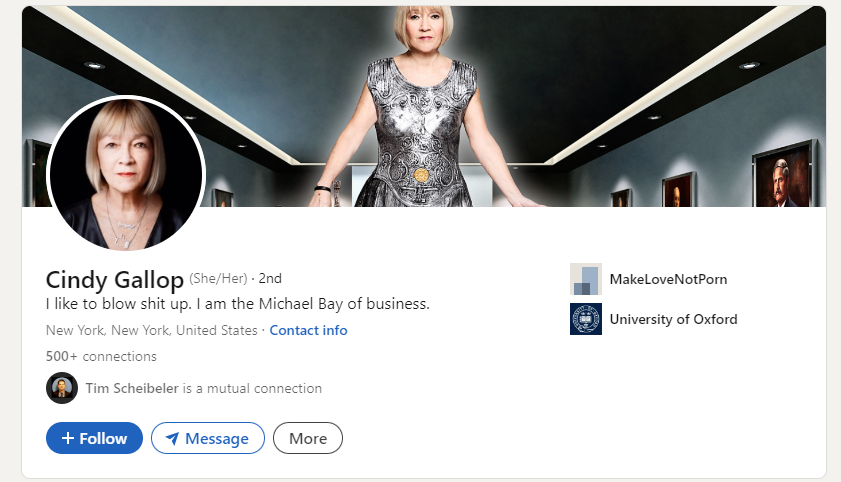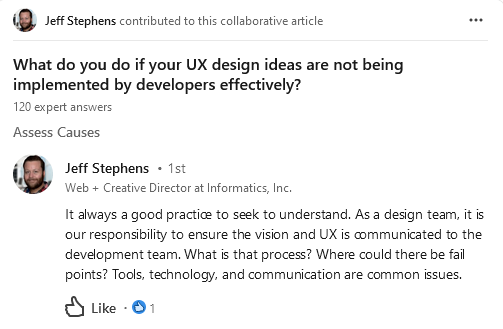LinkedIn isn’t just a place to post your resume—it’s grown into a powerful social tool for building your brand and establishing yourself as an authority in your field. With over a billion users worldwide and 134 million active users every day, it has become the go-to platform for networking, sharing insights, and thought leadership.
By making smart use of LinkedIn's features and engaging with the community, you can boost your professional presence, gain credibility, and unlock new opportunities for yourself and your business.
Here are a few tips for getting the most out of the platform from Informatics’ social experts.
Image is (Almost) Everything
Canon's famous tagline, "Image is everything," entered the pop lexicon 25 years ago, and the advice remains (mostly) true today. Like most social media sites, what you put out there is what people will use to form their impression of you and your company—on LinkedIn, it just so happens to be more about work than vacation pictures or memes. That’s why it’s so important to keep up your profile up to date and engage with conversations, to show that you indeed mean business.
1. Use Quality Images
If you’re headed to an interview or client meeting, you’re probably not just going to grab the nearest outfit and run out the door. When it comes to selecting a profile photo and background image for your LinkedIn account, you don't just snag a picture from grabbing a beer with your friends over the weekend (unless you run a hip brewpub).
Consider hiring a professional photographer to create your headshot. If you are working with a friend, or take a DIY approach with a timer and tripod, keep these points in mind:
- Wear professional attire.
- Smile with your eyes to appear welcoming.
- Avoid direct sunlight and fluorescent lighting.
- Keep the photo in focus.
- Optimize a square image at 400 pixels by 400 pixels.
A professional graphic designer can create an eye-catching background photo to complement your profile picture. But if you decide to use Canva or another design program to create your own background, here are a few more pointers to build a professional image:
- Keep it simple, avoiding complex graphics.
- Use minimal text.
- Optimize image size to 1584 pixels by 386 pixels.
Whether you take a professional or DIY approach, don't leave these images blank. Members with photos receive 21 more times profile views and 9 times more connection requests, according to the platform.
2. Write an Amazing Headline
Building a personal brand requires a deep understanding of your skills, as well as the audience that’s looking to benefit from those skills. You will ultimately communicate these values with a consistent brand voice—one more step on the road to building professional authority.
The most succinct expression of your brand voice on LinkedIn will be your headline. This can only have a max of 220 characters, so choose them wisely. Some elements of an outstanding headline include:
- Keywords for your top skills (but avoid keyword stuffing).
- Noteworthy accomplishments (e.g. Time Magazine's 100 Most Influential, 2024's Best of the Corridor, etc.)
- A voice and tone that reflects your personality.
This profile takes a bold approached and uses language that might not be appropriate for some industries. But it sure is memorable and evokes a very specific personality and mindset.

3. Solicit Endorsements for Your Skills
Your profile is an opportunity to highlight the specific professional skills you bring to the table, whether that’s digital marketing or deal making.
LinkedIn has many skill suggestions, and they can also be customized. Even if you think your headline and summary already cover the skills, do not overlook this. According to Neil Patel, profiles that list skills see a 13x boost in profile views.
But don’t just stop there. Strategically work to gain endorsements for your top skills. Peer reviews build valuable social proof—evidence that you’re not the only person who thinks you’re amazing.
One way to generate endorsements is to provide them for people with whom you’ve worked closely. Those close colleagues are often likely to reciprocate. And if they don’t return the favor within a week, it’s perfectly acceptable to reach out with a message asking for an endorsement. Remind them of a project you worked on in the past and be clear about the endorsement you’re seeking and how you intend to use it.
During this process, it’s important to aim for quality over quantity. As you work to establish yourself as a thought leader work to gain the endorsements of people who already achieved that status in your field.
Content is (Still) King
LinkedIn has over 1 million users posting content weekly, and content impressions on the site outpace job posting impressions by 15x. It’s clear that a cohesive content strategy is necessary for building the authority of your personal brand on LinkedIn, but let’s dive deeper into specific actionable steps.
4. Generate Original Content
There are differing opinions about how frequently you should be posting on LinkedIn, but our own social experts recommend 2-3 times per week. No matter the frequency, your strategy should be built around consistency. Build a content calendar to stay on track, avoiding swings between periods of hyperactivity followed by silence.
In 2023, LinkedIn articles generating the most engagement focused on these areas:
- The Future of Work
- Marketing Trends
- Amazing Feats of Marketing
It’s no surprise that marketing insights take center stage on LinkedIn, as it’s the platform of choice for B2B marketers.
In addition to articles, you can also generate content like:
- Success Stories
- Answers to common struggles in your industry
- Polls and surveys
For certification management platform ROC-P (owned by Informatics), their LinkedIn strategy revolves around personal Insights posts from Business Development Director Julia Crowley, who draws on her deep experience in SaaS platform sales to offer tips and suggestions to others in the industry.
As you’re generating content, it’s important to think about the form these pieces take. Ultimately, the level of engagement will be determined by the content’s value to your audience, but analytics do show that certain formats drive more engagement than others:
- Multi-image posts generate the most comments.
- Document posts (like whitepapers) generate the second-most engagement.
- Videos generate the most shares.
All types of posts can be valuable, but it’s worth considering your desired outcome before scheduling your content.

If all of this content generation seems like a hefty task—it can be! One way to lighten the load is to add value to content generated by other users.
5. Share and Engage in a Network Content
Sharing content posted by others can have a powerful reciprocal effect, just like endorsements. When you re-post an article by a thought leader in your industry, it may encourage them to follow and re-post your articles in the future. The key here is to add value.
For example, you are still running that hip brewpub and the president of your state’s brewing association posts an article about the highest-selling beer types for the last year. You might share this article and add your own insight: “Great breakdown of recent beer sales, but we’ve seen an uptick in sales of sours in the last quarter. Is this seasonal or maybe the start of a trend for the coming year? Thoughts?” This provides valuable information for people in your professional network and calls for people to engage.
In conjunction with sharing posts, it’s recommended to comment on posts by other thought leaders to build your authority. This increases your visibility and provides more of that social proof that you’re a real person and not a bot.
Collaborative articles are another way to engage, build social proof, and even earn a badge as a "Community Top Voice." Collaborative articles are group discussions about particular skills.
As an expert web designer, our own Jeff Stephens regularly contributes to collaborative articles on graphic design, UI/UX, and more.
LinkedIn awards profile badges to the top 5% of contributors to any skill topic. Contributions can take the form of, “personal examples, unique perspectives, and professional opinions,” and contributors’ value is weighted by, “quality, engagement, and quantity of contributions.”
The Community Top Voice badge is a powerful new distinction for users’ profile pages, and more attainable than the "Top Voices" badge, estimated to only be awarded to the top 0.5% of all LinkedIn content generators.

Ultimately, the keys to building brand authority on LinkedIn align with other platforms in the digital sphere: Stay connected with professionalism, consistency, and a focus on outcomes.
Connect with Informatics today if you’re ready to deepen your B2B connections and build your authority as an industry thought leader.
Ready to build your social presence?
Our Digital Marketing experts can help you make valuable connections online.

